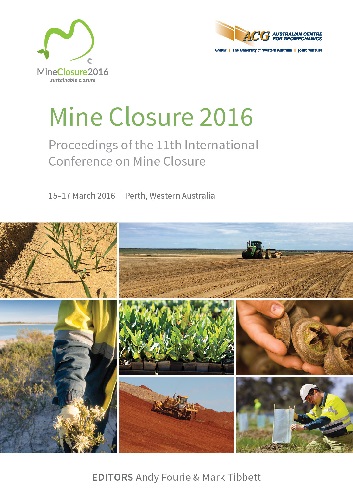Designer waste landform modelling and design — Rum Jungle Mine

|
Authors: Taylor, I; Kemp, A; O’Kane, M; Walker, S; Barteaux, M; Laurencont, T |
DOI https://doi.org/10.36487/ACG_rep/1608_29_Taylor
Cite As:
Taylor, I, Kemp, A, O’Kane, M, Walker, S, Barteaux, M & Laurencont, T 2016, 'Designer waste landform modelling and design — Rum Jungle Mine', in AB Fourie & M Tibbett (eds), Mine Closure 2016: Proceedings of the 11th International Conference on Mine Closure, Australian Centre for Geomechanics, Perth, pp. 405-417, https://doi.org/10.36487/ACG_rep/1608_29_Taylor
Abstract:
Rum Jungle is a former uranium mine site near Batchelor in the Northern Territory. Historical mining activities at the site between 1952 and 1971 have led to ongoing and adverse impacts on the surrounding environment. Sulfidic mine waste is prevalent in the Main and Intermediate Waste Rock Dumps (WRDs) and consequently, Acid and Metalliferous Drainage (AMD) is a problem. Even though a technical assessment after rehabilitation determined that the engineering and environmental criteria were met, ongoing impacts have led to contemporary water quality standards not being met in the East Branch of the Finniss River and soils around the site, and led to poor vegetation establishment and coverage. The Department of Mines and Energy (DME) is directing a collaborative, multi-phased rehabilitation planning process for the site. The Former Rum Jungle Mine Site Conceptual Rehabilitation Plan (CRP) (2013) outlines the objectives, the rehabilitation approach and preferred rehabilitation strategy for the mine site. Objectives for the site are to provide geotechnical and geochemical stability so as to allow for sustainable land uses by traditional Aboriginal owners of the site. To achieve these objectives, it is proposed to relocate all existing above ground WRDs, to either backfill the Main Pit void, or a single, stable and aesthetic waste storage facility (WSF) which will be constructed on site. Development of the strategic approach and detailed design of civil engineering works is currently underway to manage geochemically and radiologically active mine waste prevalent across the site. O’Kane Consultants Pty. Ltd. (OKC) is preparing rehabilitation designs for the overall site, supported by various (ongoing) technical assessments for the WSF and Main Pit. The detailed numerical modelling includes a material balance assessment, waste placement and oxygen ingress modelling, waste wetting up and drain down modelling, cover system and landform evolution modelling. The control of surface water, seepage, and erosion in the long-term and during construction is central to achieving the rehabilitation objectives. As such, assessment of the proposed WSF geometric design methodology by the practical implementation of landform evolution models, including Water Erosion Prediction Project (WEPP), SIBERIA and CAESAR-Lisflood is being completed. These models are used in conjunction with sophisticated terrain modelling software (Civil 3D) to assess future stability based on surface materials and desired landform geometry. The assessment methodology is based on lab testing and observations of erosion on existing landforms, and the validation adds confidence to the assessment. This enables improved aesthetic design for the proposed WSF, an important design objective, and can provide confidence in stability of the landform over long time frames. The results of the detailed assessments by OKC and other consultants are used to conduct ongoing detailed engineering designs for the overall site including the design of the WSF with appropriate waste placement specification, a natural shape and provide long-term surface stability. This paper discusses the overall approach and integration of the various technical studies and supporting numerical assessments.
Keywords: waste landform design, waste landform evolution, waste landform modelling
References:
DME (Northern Territory Department of Mines and Energy) 2013, The Former Rum Jungle Mine Site Conceptual Rehabilitation Plan, Northern Territory Government, Darwin.
Flanagan, DC, Frankenberger, JR, Cochrane, TA, Renschler, CS & Elliot, WJ 2013, ‘Geospatial Application of the Water Erosion Prediction Project (WEPP) Model’, American Society of Agricultural and Biological Engineers, vol. 56(2) pp. 591–601.
Hancock, GR, Loch RJ, Willgoose, GR 2003, ‘The Design of Post-Mining Landscapes Using Geomorphic Principles’, Earth Surface.
INAP (International Network for Acid Prevention) 2015, Draft Global cover system design technical guidance document, INAP, July 2015.
Krahn, J 2004, Vadose zone modelling with VADOSE/W – An engineering methodology, First Edition, GEO-SLOPE International Ltd, May.
© Copyright 2026, Australian Centre for Geomechanics (ACG), The University of Western Australia. All rights reserved.
View copyright/legal information
Please direct any queries or error reports to repository-acg@uwa.edu.au
View copyright/legal information
Please direct any queries or error reports to repository-acg@uwa.edu.au